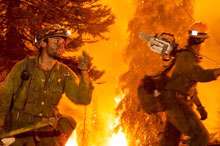No products in the cart.
Trial by Fire

Fighting for the Forest Service
By Mike Blackbird
The devastating wildfires of 2015 burned more than 740,000 acres in Idaho, and when fire season came around again in 2016, I was reminded of the infamous 1910 forest fire.
Its history and high cost are well known to the citizens of Shoshone County, where I grew up, because it consumed the city of Wallace, the county seat. The 1910 firestorm destroyed three million acres of prime forestland (approximately the size of Connecticut) in the panhandle of northern Idaho, in northeastern Washington, and in western Montana. It escalated over two days in August and killed eighty-seven people, including seventy-eight firefighters. It is believed to be the largest, although not the deadliest, fire in recorded U.S. history. In my youth, it was still possible to see fire-scorched snags on the mountainsides of the Silver Valley, standing as stark testaments to the ravages of wildfire.
When the Pilgrims landed at Plymouth Rock, a squirrel could travel all the way from the Atlantic coast to the Mississippi River without ever touching the ground. By the end of the 19th Century, the timber trusts had exploited the old-growth forests of the East and now cast covetous eyes on the huge timber stands of the West, particularly the Northwest. The cut-and-run business model that had devastated forests of the East would have succeeded here, but for the apocalyptic 1910 fire and an entity that contemporary environmentalists generally do not view as an ally: the U.S. Forest Service. Indeed, one can say that this event was the young Forest Service’s “trial by fire,” which solidified support of the agency during its turbulent beginnings.
This content is available for purchase. Please select from available options.
Register & Purchase Purchase Only
Register & Purchase Purchase Only

